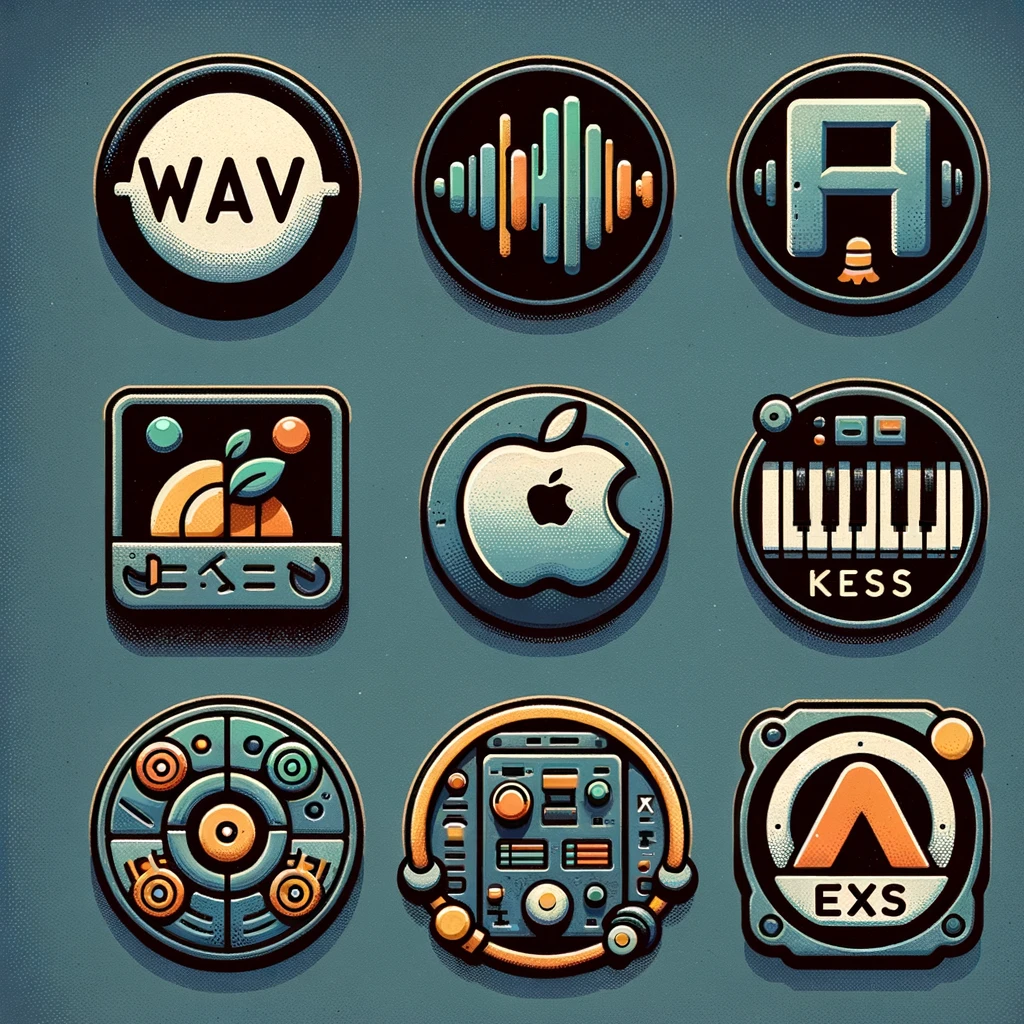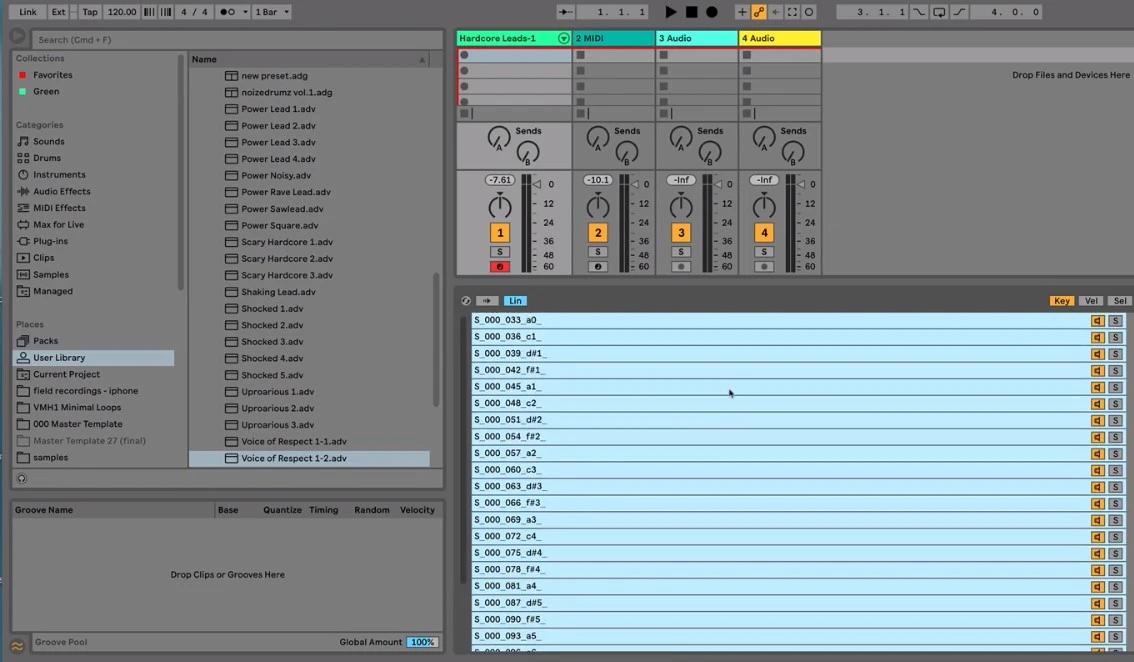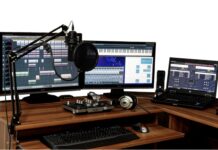Sample pack is a collection of audio samples and loops that music producers can use in their own productions. Producers commonly load these sounds into a digital audio workstation and arrange the loops, one-shots, and instruments into full musical compositions, beats, and songs.
Within the DAW, samples can be edited, processed, pitch-shifted, and combined with virtual instruments and MIDI patterns to create original productions.
As sampling and loop-based music creation has become more accessible and widespread, sample packs have emerged as a vital resource for Bedroom producers, DJs, and musicians looking to expand their sonic palette without recording original sounds.
But what exactly goes into a sample pack, and how does one choose the right pack for their needs? This article will explore the world of sound packs and provide an overview of their key components.
Table of Contents
Defining the Basics: What Makes a Sample Pack
At its core, a sample pack contains a set of audio samples – short digital recordings of sounds, instruments, and loops. These samples are organized into folders and catalogued so users can easily find the sounds they need for a production. Packs can include one-shot drum hits, isolated instrument recordings, vocal hooks, synth stabs, bass loops, guitar licks, and full music loops across any genre. The samples may be dry (just the recorded sound) or offer effects like delay, reverb and compression so they’re ready to drop into a mix. The defining factor is that all the audio is royalty-free for use in original productions.
The Components of a Sample Pack: Loops, One-Shots, Construction kits and Midi
Sample packs contain a variety of specific audio elements:
Loops – Short, repeating instrumental or rhythmic phrases that producers can loop continuously in a song. Drum loops, basslines, chord progressions and full musical sections are common loop types.
One-shots – Single drum hits, synth/instrument notes, snares, kick drum or vocal samples that aren’t looped. Producers use one-shots to build drum kits and melodies note-by-note.
Construction kits – Pre-made combinations of loops and one-shots arranged into full sections of a song like intros, verses, and choruses.
FX samples – Single sound effects like impacts, risers, white noise sweeps and more.
Vocal samples – Hooks, phrases, individual sung or spoken words/syllables.
MIDI samples – audio samples that respond dynamically to MIDI data for expressive and flexible playback, as opposed to static audio clips.
In many cases, a sample pack will contain hundreds or even thousands of samples from multiple categories to provide deep creative possibilities. The specific contents depend on the pack’s concept and genre.
Genre Varieties: From Hip-Hop to EDM
Sample packs come in a huge range of genres and subgenres. Here are some of the most common:
- Hip-hop – Drum kits, urban loops, vinyl scratches/noises, vocals.
- EDM – Synth stabs, bass loops, builds, drops. Dubstep and House packs are very popular.
- Pop – Modern instrumentation, vocal hooks, acoustic/electronic hybrid loops.
- Orchestral – Strings, piano, choirs, horns, percussion ensembles.
- Rock – Live/programmed drums, guitars, vintage keys, general band loops.
- Jazz – Full jazz combo sections, upright bass, piano, jazz drum kits.
- Electronic – Atmospheres, experimental sounds, glitches, modular synths, vintage keys/drums.
- World/Ethnic – Regional drums, woodwinds, vocals, percussion, and instrumentation.
So whether seeking gritty boom-bap hip-hop drums or lush EDM chord progressions, producers can find libraries tailored to their specific music style.
File Formats and Compatibility Issues
Sample packs are available in all the major audio file formats:
- WAV – Uncompressed audio for maximum quality. Large file sizes.
- AIFF – Apple format, similar quality to WAV.
- REX – Specialized loop format for Propellerhead Reason DAW.
- Kontakt – For Native Instruments Kontakt sampler/libraries.
- EXS – For Logic EXS24 sampler.

Most packs today are offered as WAV/AIFF files for maximum compatibility with all major music software and hardware samplers. REX, Kontakt and EXS formats are still common but mainly used with their associated instruments.
Understanding Bitrate and Sample Rate
Two technical factors affect the sound quality of a sample pack:
Bitrate (sample resolution) – Common values are 16-bit and 24-bit. Higher bitrates capture more dynamic range and fidelity.
Sample rate (sampling frequency) – Common values are 44.1 kHz and 48 kHz. Higher rates capture higher frequencies and improve audio quality.
So a pack offering 24-bit, 48 kHz WAV files would be considered high-resolution and studio-quality. Lower resolutions like 16-bit/44.1 kHz are still very usable in productions, though. The optimal balance of sound quality and manageable file size depends on each producer’s needs and resources.
Sound Quality and Selection Criteria
When evaluating sample packs, producers consider many factors regarding the actual audio content itself:
– Performance quality – Do virtual instruments/recordings sound realistic and well-captured? Are loops tight and well-performed? Are samples edited cleanly without glitches?
– Diversity – Does the pack offer a wide range of sounds and loops so you’re not stuck repeating the same ones?
– Editability – Do loops have extra pad time so they’re easy to trim and tweak for different usages?
– Mixing/processing – Are sounds balanced, EQ’ed and compressed for quick use in mixes? Or left untreated for your own sound design?
– Organization – Does the library categorize sounds intuitively and allow easy browsing/searching?
– File naming – Are samples named cleanly and consistently? Or confusing and cluttered?
– Tempo accuracy – Do loops and phrases maintain their stated BPM precisely, or waver in timing? Tight BPM is crucial for syncing loops together smoothly.
By checking the quality and diversity of the actual sounds themselves, rather than just genre claims or marketing hype, producers can determine which packs offer substance over flash.
Quantity or Quality
Sample pack developers have to strike the right balance between quantity and quality. Some packs focus on providing massive libraries with hundreds of gigabytes of content. Others concentrate on delivering a smaller set of premium, hand-crafted samples. There are use cases for both approaches:
Quantity – Great for “all-in-one” packs that aim to provide almost endless sonic options. Allows digging for gems amidst a huge variety. Useful for experimentation.
Quality – Better when seeking a hyper-focused set of sounds for a genre. Streamlined workflow without plowing through filler. Great for easily matching samples tonally.
There’s no universally ideal amount of samples. It depends on each producer’s budget, storage resources, and preferred workflow. Large sample libraries invest in storage while tailored packs offer instant usability.
DRY and WET
Another decision in sample pack design is providing dry (untreated) vs wet (effected) samples. Each approach has advantages:
DRY samples – Allow producers full creative control to shape sounds with their own processing like reverb and delay. Great for mixing cohesion.
WET samples – Immediately usable in mixes as-is. Provide inspirational effected textures right away. Save time vs. programming effects.
Many sample packs strike a balance with both dry and wet options, or different effected versions of each sample. This flexibility empowers the user to utilize sounds however desired in their production.
Prices
Sample pack prices vary based on duration, size, quality and brand reputation. Here are some typical price ranges:
$Free – Many free packs are available, often serving as promotional tools for paid products or containing basic sounds. Useful for beginners.
$5-$50 – Modestly priced packs from lesser-known creators or aggregators. Varying quality levels.
$50-$150 – Mid-priced packs from established companies like Splice and Loopmasters. High quality and usability.
$150-$300 – Boutique packs with unique concepts, niche sounds, premium editing. Prime tools for pro producers.
$300+ – Multi-gigabyte all-in-one packs from top-tier developers like Noiiz and Cymatics. Extensive but expensive.
Of course, spending more doesn’t guarantee satisfaction, and gems can be found even in free packs. But generally, more expensive packs match their price in terms of production rigor, sound quality, uniqueness and brand curation. Producers should set a budget appropriate to their needs.
Software and Hardware
To utilize sample packs effectively in music production, the right software and hardware helps:
DAW (Digital Audio Workstation) – All major DAWs like Ableton Live, Logic Pro, FL Studio and more support importing sound libraries and dragging/dropping samples into tracks.
VST Plugins – Virtual samplers/romplers like Kontakt and UVI allow playing and manipulating samples like instruments. Effects plugins shape sound.
Audio interface – A USB interface with decent inputs/outputs ensures clean sound transfer in and out of the DAW when using samples.
Monitors – Studio monitors or quality headphones are vital for evaluating the sonic nuances of different samples as you produce.
MIDI keyboard/controllers – Hardware instruments/pads to play samples chromatically via MIDI as well as finger drumming.
External hard drive – Storing sample packs separately from your system/apps drive helps improve performance for big libraries.
Having the right gear helps producers experience all a sample pack has to offer. But many packs work successfully even with basic gear to start out.
Copyright Concerns
Because sampling inheres copyright complexities, it’s crucial sample packs adhere to legal standards through proper licensing:
Royalty Free – Almost all packs today are licensed royalty-free, meaning you’re free to use the samples in commercial or non-commercial productions without owing royalties.
License Agreement – Reputable companies provide a license pdf detailing usage rights and any restrictions. It’s important to read and adhere to these to avoid legal issues.
Sample Clearance – Legit companies clear all samples from unlicensed sources and ensure no copyright infringement. This protects producers legally.
Understanding these terms means you can use packs freely within reason without worrying about unclear samples causing problems down the road. Handle packs claiming to be “100% royalty-free” without licensing info with skepticism.
Free vs. Paid Sample Packs: Pros and Cons
Producers have the choice between free sample packs from various sources, and paid packs from dedicated sample developers. There are pros and cons to each approach:
Free Packs
Pros:
- Totally free to download and use. Great for beginners
Cons:
- Varying quality levels
- Limited selection and variety
- Use restrictions sometimes
- Legal uncertainty around clearance
Paid Packs
Pros:
- Often higher quality recording/editing
- Huge selection and variety
- Royalty-free use guaranteed
- Curated concepts and genres
Cons:
- Cost money to purchase and collect
- Can get expensive buying many
In general, paid packs deliver more value, uniqueness and legal assurances. But free packs can still provide useful starter tools on a budget. Many producers use both strategically.
The Debate: Sample Packs vs. Original Recordings
There’s some debate around how heavily producers should rely on sample packs vs. recording original sounds themselves:
Pro Sample Packs:
- Huge time saver vs. programming/recording from scratch
- Provides sounds hard to create, like pro vocalists
- Mix-ready processing done for you
- Cost effective for hobbyists
Pro Original Recordings:
- Unique, fully original sounds.
- Ability to capture any real instrument.
- Total creative control.
- Develops musicianship/sound design skills.
In practice, most producers strike a balance using both sound libraries and original recordings strategically. This enables efficiency when needed but still allows personalized, proprietary sounds.
Do popular producers use sample packs?
Short answer – yes! Almost all music producers today utilize sample packs for certain needs:
– Top EDM DJs layer loops, one-shots and FX from packs into tracks for richness, variation and unique textures not found in synths alone.
– Hip-hop/rap producers dig for obscure vinyl grooves in sound libraries to lend an old-school vibe along with modern trap drums.
– Pop producers use drum samples and vocal hooks from packs as songwriting aids, then replace them with original recordings later.
– Songwriters grab chord loop progressions from packs to quickly sketch song ideas and get creative momentum.

So rather than a crutch, pros see sample packs as secret weapons for creativity and efficiency. Even purists recording live instruments will grab an extra shaker loop or drum fill from a pack when needed. Used tastefully, they help make productions more impactful and inspired.
Conclusion
As we’ve explored, sample packs offer an abundant buffet of sounds for all styles of music production today. At their best, they provide sonic fuel for igniting ideas and providing elements difficult to recreate from scratch. By understanding the types of sounds included, finding packs suited to your genres, setting budgets and learning legal usage rights, music producers can effectively harness sample packs as part of a productive, creative workflow. With the right approach, these ready-made building blocks can help construct your next hit.






